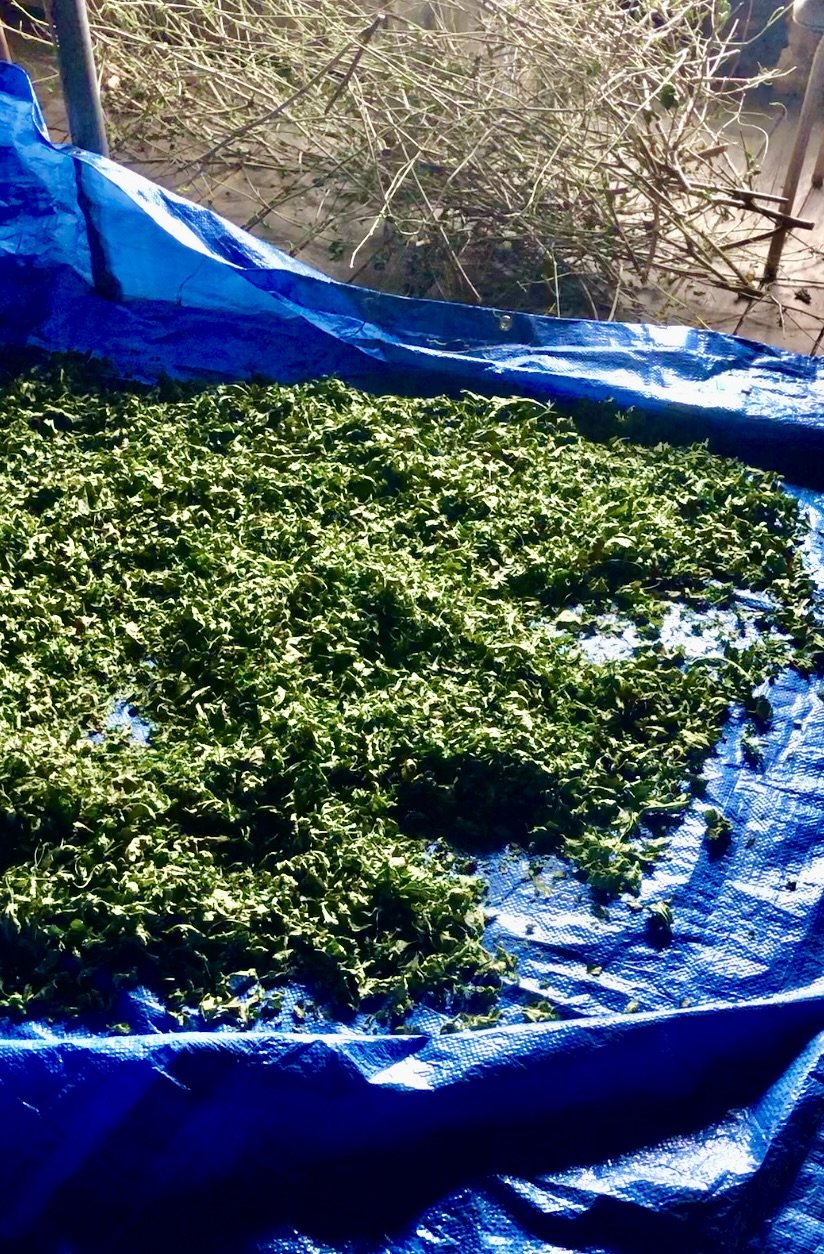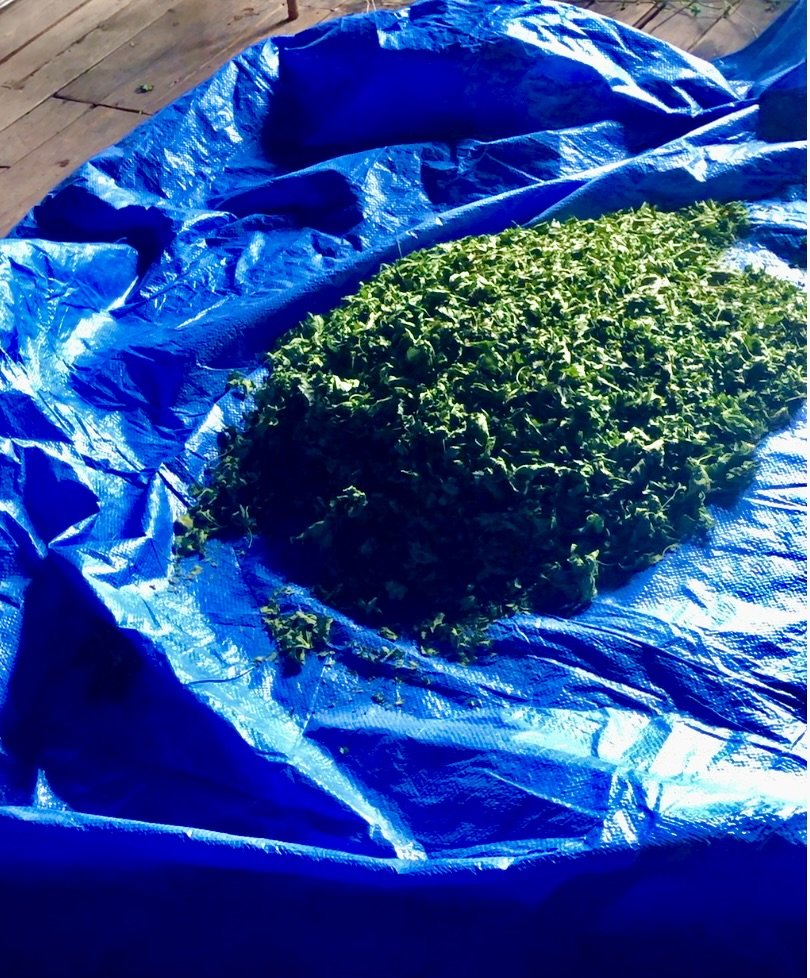Come and Garble Mulberry with Me!
There are many words that we speak as herbalists which are specific to our work with people and plants. Top of my list is “borborygmus”, which I learned from David Winston. It refers to the gurgling, grumbling and rumbling sounds that occur as water and gas move through our intestines. It’s pronounced /ˌbôrbəˈriɡməs/.
My second all-time favorite herbal term is “garble”.
From its Latin roots, to its use in Arabic and old Italian, right through to its entry into English (actually Middle English), it’s a verb that essentially means “to sift”.
In general parlance, we talk about garbled speech or garbled thoughts; lacking enunciation or with respect to ideas, lacking clarity or not being well thought out, i.e., things that are mixed up and jumbled. This lack of purity is what we’re referring to when we “garble herbs”.
So let’s take a step back. If garbling means to sift, or to put it another way, to separate, then we certainly need an herb to garble.
This week, in late August, I’m once again working with mulberry and in particular, it’s leaf. Historically, mulberry leaves were relied upon for any number of virtues and I’d be happy to elaborate upon this when we meet so that we have a chance to explore these applications further.
Morus
Mulberry’s Latin name is Morus which some say, amusingly, means “mulberry tree”. Within the genus Morus, multiple species have been identified. However, here in the northeast of the States, and in particular in and around Erie Pennsylvania, we have three common species;
Morus nigra, M. rubra and M. alba. They are distinguished not simply by the colors of the berries but also their leaves.
White mulberry, Morus alba, is thought to be an invasive here in the States. While this word often has rather negative connotations, as an herbalist I hear this word and I think
“opportunity”. I am curious to know what has changed for a species to be classed as invasive; to what extent might this be a result of human actions. Additionally, I wonder why this plant medicine moving in. Maybe we need it!
Respiration and more
Mulberry leaves have been relied upon in Traditional Chinese Medicine and in native North American medicine for centuries. While they have a multitude of applications, I often find that they are immensely helpful when it comes to supporting respiration. Yes, breathing.
Whether or not I am working with respiratory symptoms associated with poor inner-city air quality, seasonal allergies, colds and flu or, more recently these last years, the smoke from the wildfires that have ravaged parts of North America and Canada, mulberry leaves offer relief.
I invariably find that a tea* made from this leaf relieves constriction, opens the airways and relatively quickly aids breathing.
Berry good
I am indeed fortunate to live in a region of the States where mulberry trees abound. Many find them a nuisance, due to the berries dropping but again – it’s all a matter of one’s point of view!
The berries are rich in flavonoids and vitamin C. They can be relied upon to support mucus membranes, the immune system, cardiovascular health and even our eyesight. And guess what? They’re free!
Why aren’t more people interested in this remarkable addition to smoothies, oatmeal, fruit salads and even pies? It’s been suggested too that mulberries offer greater immune support than elder berries. How’s that for a wee gem!
It’s worth noting, as an aside, that the phrase “food desert” has been applied very broadly to areas where natural abundance is overlooked in favor of packaged goods and capsules.
“… here we go ‘round the mulberry bush …”
While a once popular song suggested that mulberry grew as a bush, white mulberry often reaches 30-50 feet in height. Luckily for me, I share a living space with a mulberry which is about 15 feet tall. That said, it can be seen from the image below that I have begun pruning to about 8 feet, without reliance on ladders. I often lay a sheet on the ground to catch stems as I cut, or for a small harvest, I deposit cuttings directly in a wheelbarrow.
I prune by hand and not with electric sheers to avoid disturbing nests and any animals that may be throwing a house party. Small hand held secateurs or pruners are more than adequate for most branches. If necessary, I’ll reach for loppers. I harvest only when it’s dry.
Harvesting and garbling
Harvesting involves correct identification; time to cut, garble and shape; dry (which is more dependent on space than time); continued garbling and then storing or making a tincture or another form of medicine to be dispensed. Time is key.
Each complete harvest involves 3-4 passes around the tree and can take anywhere from 1-3 hours per pass. It’s pleasing work and easy to fall into a quiet rhythm. It’s always important for me to remember to harvest only what I need and what I can process.
As I am cutting, I am garbling. Birds leave nesting remains, the winds can damage branches and leaves may wither. I set these aside from my harvest. Invariably, I find that grasses blow into myharvest on a windy day, or I come across the odd leaf that has yellowed or died. These are removed as I garble outdoors before bringing material indoors to dry. While it may seem unimportant, the removal of the dross ensures a higher quality product.
My first 2-3 cuts are relatively crude as I trim the sides back about 2-3 feet. While I do pay attention to shaping, I only address symmetry and detail after I harvest the top-most branches on my last cutting.
Mulberry after two cuttings, 3d apart
Drying and Garbling
When I’m drying larger volumes, herbs are brought indoors and spread out on a tarp in the attic. On these late August days, temperatures in the attic exceed 90F (32C). The air is dry and not at all humid.
First I spread branches out on the tarp. Note, I have not yet removed leaves as it’s easier to do this when the leaves have dried. Branches get turned twice a day.
Removing leaves from their branches
Second, I remove leaves from each branch, simply running my hand along each one with a loose grip. Let’s not forget that the bark of mulberry is also important medicinally, however just now, I am harvesting leaves both for sale and to last until next spring when I’ll harvest again. Leaves are left to dry for another 1-2 days.
Removing leaves is a relatively speedy process, certainly faster than cutting. I continue garbling, removing the dross, small stems that remain while loosely rubbing dried leaves between the palms of my hands to resemble what herbal suppliers term, “cut and sifted”. I “fluff” or turn leaves regularly (I prefer the word “fluff”!).
Ensuring that our herbs are truly dry is key or they will mold.
Ordering herbs?
When we order herbs from local growers or large suppliers, we have a few choices. They can be whole. For example, I order whole licorice roots. We can order powdered herbs. However, often powdered herbs have a shorter shelf life as they have the largest surface area. We can order cut and sifted herbs which are loosely crushed.
Do remember to garble herbs purchased from suppliers, whether or not they’ve been purchased from nationally recognized suppliers or a local grower. It’s good practice.
If purchasing herbs by weight, I have on occasion weighed what I have garbled from a purchase. I have found feathers, grasses, stones and twigs, each contributing to the weight of my purchase to a greater or lesser extent.
Well garbled herbs make good medicine.
Garbling gives us an opportunity to spend additional time with the herbs that we harvest as we further get to know their vibrant colors, their aromas and how they feel. We have the pleasure of carrying this experience with us, and in us.
Garbling promotes safety and brings joy and peace.
Happy garbling
* to make a tea: steep 1-2 teaspoons of dried mulberry leaf per mug of boiled water for about 15 minutes. Two to three mugsful of tea per day regularly offers ease.
Curious about the real-world applications of herbs? Perhaps you're seeking a deeper understanding? Become my newsletter pal and get FREE access to my monthly Live Q&A sessions!




